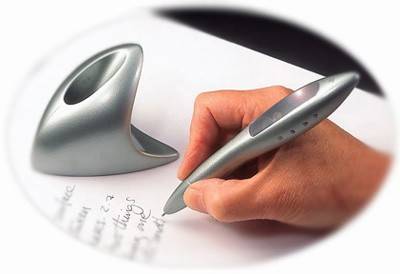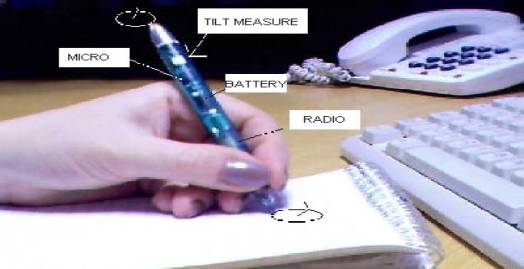





Published on Apr 02, 2024
Lyndsay Williams of Microsoft Research's Cambridge UK lab is the inventor of the Smartquill,a pen that can remember the words that it is used to write, and then transform them into computer text . The idea that "it would be neat to put all of a handheld-PDA type computer in a pen," came to the inventor in her sleep . "It's the pen for the new millennium," she says. Encouraged by Nigel Ballard, a leading consultant to the mobile computer industry, Williams took her prototype to the British Telecommunications Research Lab, where she was promptly hired and given money and institutional support for her project.
The prototype, called SmartQuil, has been developed by world-leading research laboratories run by BT (formerly British Telecom) at Martlesham, eastern England. It is claimed to be the biggest revolution in handwriting since the invention of the pen. The sleek and stylish prototype pen is different from other electronic pens on the market today in that users don't have to write on a special pad in order to record what they write. User could use any surface for writing such as paper, tablet, screen or even air. The SmartQuill isn't all space-age, though -- it contains an ink cartridge so that users can see what they write down on paper. Smart Quill contains sensors that record movement by using the earth's gravity system, irrespective of the platform used. The pen records the information inserted by the user. Your words of wisdom can also be uploaded to your PC through the "digital inkwell", while the files that you might want to view on the pen are downloaded to Smart Quill as well.

It is an interesting idea, and it even comes with one attribute that makes entire history of pens pale by comparison-if someone else picks your SmartQuill and tries to write with it- it won't. Because user can train the pen to recognize a particular handwriting. Hence SmartQuill recognizes only the owner's handwriting. SmartQuill is a computer housed within a pen which allows you to do what a normal personal organizer does .It's really mobile because of it's smaller size and one handed use. People could use the pen in the office to replace a keyboard, but the main attraction will be for users who usually take notes by hand on the road and type them up when returning to the office. SmartQuill will let them skip the step of typing up their notes.
SmartQuill is slightly larger than an ordinary fountain pen. Users can enter information into these applications by pushing a button on the pen and writing down what they would like to enter .The SmartQuill does not need a screen to work. The really clever bit of the technology is its ability to read handwriting not only on paper but on any flat surface - horizontal or vertical. There is also a small three-line screen to read the information stored in the pen; users can scroll down the screen by tilting the pen slightly.

The user trains the pen to recognize a particular handwriting style - no matter how messy it is, as long as it is consistent, the pen can recognize it. The handwritten notes are stored on hard disk of the pen. The pen is then plugged into an electronic "inkwell" ,text data is transmitted to a desktop computer, printer, or modem or to a mobile telephone to send files electronically. Up to 10 pages of notes can be stored locally on the pen . A tiny light at the tip allows writing in the dark. When the pen is kept idle for some time ,power gets automatically off.
" Display technology used in SmartQuill
" Handwriting recognition and signature verification
" Display scrolls using tilt sensors
" Communication with other devices
" Memory and power
• SmartQuill isn't all space-age. It contains an ink cartridge so that users can see what they write on paper. Hence a simple application of SmartQuill is that it write notes on paper. This information recorded in the pen is then downloaded to PC .
• The information stored in the pen can be input to other devices such as mobile phones, printers ,modems,desktop computers etc for different applications.
• It also provides handheld computer applications such as digital diary, contacts, calculators etc.
• It is used for receiving pager and e-mail messages. This is possible through recent technology involved in SmartQuill, the wireless messaging system which allows two way communication between devices .
This software embedded in the microprocessor of the pen is used to recognize handwriting of the user. Pen works in conjunction with a regular PC on to which users install special handwriting recognition software. The handwriting recognition software translates movements in to text on screen.
Handwriting recognition software constitutes two major phases:
1. Handwriting transcription
2. Handwriting recognition
Handwriting transcription
In this phase,the recorded acceleration signals are then transcripted to it’s original form. Here this aspect is solved using ‘simple’ double integration method in order to retrace the pen tip movement on paper.
In order for this principle to work properly,we have to solve two main problems:
Firstly, we have to know pen’s spatial orientation in order to withdraw the earth gravity component to the measured accelerations.Secondly , we have to succeed in the double integration, which is to solve all the derivation problems due to this method.
By tilting the pen, user can choose applications and scroll through with out using scroll buttons. Below is an image of SmartQuill tilting Screen designed by Lyndsay Williams for BT Labs in 1997. The pen would align text if it was held in left or right hand so the text was the correct way up for left or right handed people. This was done by using Micro Electromechanical Systems (MEMS) tilt sensors to measure tilt angle to earth . The SmartQuill microcontroller read the angle and then mapped the large screen display onto the small 4 line display. SmartQuill could also scroll through pages of display by tilting it in the hand and power off if no hand movement was detected or pen was flat on a desk. The demonstration unit below shows display inverting as SmartQuill was inverted in the hand. The choice of words was limited to what characters the LCD display driver could show while upside down (left hand picture) – only 14 of the 26 letters of the alphabet were usable. These 14 characters were then processed by anagram software to produce 900 words that used these characters. The shopping list below was produced from this limited dictionary to demonstrate the text inversion .
Earlier SmartQuill models developed by BT laboratories communicated with the PC via a radio transmitter, but the current prototype hooks up to a PC via a cable and electronic docking station called an "inkwell." .The data stored in the memory is uploaded to the personal computer when it is placed in to a docking station. An electronic docking station is a small cabinet to which a laptop or notebook computer can be attached for use as a desktop computer ,usually have a connector for externally connected devices, such as hard drives or scanners and ports that can be linked to components such as keyboard, monitor and printer. It can also be connected to printer,modem or mobile phones to send data electronically.
The output accelerometer signals from the pen are digitized with a National Instrument capture card with a frequency Fe of 1000Hz and a low pass filter at Fc=1/3*Fe .
Future models could receive e-mails and pager messages via a wireless messaging system .This enables two-way wireless communication with other computing devices .
SmartQuill has 4MB EEPROM memory. At a time, up to 10 pages of notes can be stored locally on the pen. The data is stored in the memory on the pen until it is uploaded to the personal computer. SmartQuill works by measuring the pen's movements and matching them to the movements that produce letters and words programmed into its memory. It's similar to the way a microphone detects sound.
SmartQuill is powered by AAA battery. It will run for about 25hrs on a single AAA battery. The pen exhibits automatic power on/off system. The pen will power down after a period of no movement. So it supports automatic on/off system.
SmartQuill isn’t all space-age. It contains an ink cartridge so that users can see what they write on paper. Hence a simple application of SmartQuill is that it write notes on paper. This information recorded in the pen is then downloaded to PC .
The information stored in the pen can be input to other devices such as mobile phones, printers ,modems,desktop computers etc for different applications.
It also provides handheld computer applications such as digital diary, contacts, calculators etc.
It is used for receiving pager and e-mail messages. This is possible through recent technology involved in SmartQuill, the wireless messaging system which allows two way communication between devices .
SmartQuill synchronizes files, e-mails and messages to PC.
SmartQuill can be used for voice record and supports speech recognition. Voice record is made possible through ADPCM speech compression .
SmartQuill also allows third party to add on applications.
One of the major asset is that SmartQuill does not need a screen to work. This is possible through revolutionary "Spatial Sensing" system which uses semiconductor accelerometers. Accelerometers senses pen/hand movement instead of shapes.
SmartQuill provides intuitive user interface.
Security – Security is another important feature.It is made possible through two facilities:
• It enables handwriting recognition .User can train the pen to recognize a particular handwriting style. The symbols regularly used by user gets stored in the memory, by frequent use of the pen. Hence the pen accepts only the owner’s handwriting and rejects intruders handwriting.
• It enables signature verification.Hence Passwords could be enterd in the form of signatures .
The SmartQuill is also a 3D-mouse, when twisted in air in a certain way it enables scrolling of the screen. It also automatically detects left or right handed use.
Power saving
• Small screen size requires less battery power .
• No movement of the pen causes auto power down
SmartQuill is all mobile, smaller in size and enables one-handed use.
The estimated cost of this futuristic pen is around $200.SmartQuill supports two factors: small size and convenient use. The future of SmartQuill ensures all computation power the user needs right inside the pen. Reducing the size of handheld computers can only be taken so far before they become unusable. Keyboards become so tiny you require needle-like fingers to operate them and screens that need constant cursor controls to read simple text. The introduction of SmartQuill is the best solution for this problem.
| Are you interested in this topic.Then mail to us immediately to get the full report.
email :- contactv2@gmail.com |